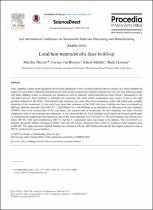JavaScript is disabled for your browser. Some features of this site may not work without it.
- ResearchSpace
- →
- Research Publications/Outputs
- →
- Journal Articles
- →
- View Item
| dc.contributor.author |
Theron, Maritha

|
|
| dc.contributor.author |
Van Rooyen, Corney

|
|
| dc.contributor.author |
Malabi, Khorommbi P

|
|
| dc.contributor.author |
Hoosain, Shaik E

|
|
| dc.date.accessioned | 2020-03-19T07:47:54Z | |
| dc.date.available | 2020-03-19T07:47:54Z | |
| dc.date.issued | 2019 | |
| dc.identifier.citation | Theron, M. et al. 2019. Local heat treatment of a laser build-up. Procedia Manufacturing, vol. 35, pp. 377-382 | en_US |
| dc.identifier.issn | 2351-9789 | |
| dc.identifier.uri | https://www.sciencedirect.com/science/article/pii/S2351978919306912 | |
| dc.identifier.uri | https://doi.org/10.1016/j.promfg.2019.05.055 | |
| dc.identifier.uri | http://hdl.handle.net/10204/11342 | |
| dc.description | Copyright 2019 The Authors. This is an open access article under the terms of the Creative Commons Attribution License, which permits use, distribution and reproduction in any medium, provided the original work is properly cited. | en_US |
| dc.description.abstract | Laser cladding or laser metal deposition involves the deposition of any weldable material onto the surface of a metal substrate by means of a laser beam. Although clad deposits are fully fusion-joined to the substrate material, the very low heat-input associated with laser cladding results in extremely low dilution as well as relatively small heat-affected zones (HAZ). Subsequent to the clad-repair process, heat treatment is normally not necessary, but some critical components may require it due to the high hardness obtained in the HAZ. Conventional heat treatments are most often time-consuming, costly and could cause possible distortion of the component. In this study local laser heat treatment of the HAZ after laser cladding has been investigated on different substrate materials (21CrMoV5-11, X22CrMoV12-1, 34CrNiMo6) as an alternative to full post-weld heat treatment (PWHT). Due to the focused heat of the laser beam, the required time at temperature for heat treatment was only a fraction compared to that of conventional heat treatments. It was observed that the HAZ hardness could indeed be lowered significantly by controlling the temperature and interaction time of the local treatment. For 21CrMoV5-11 the HAZ hardness was decreased to below 400 HV with most treatments at 800 °C, but the 8 s interaction time was found to be optimal. The X22CrMoV12-1 material showed the highest resistance to PWHT and only the longest interaction time at 800 °C resulted in HAZ hardness close to 400 HV. The largest decrease in HAZ hardness was obtained with the 34CrNiMo6 material and the longest interaction time at 700 °C resulted in the lowest hardness. | en_US |
| dc.language.iso | en | en_US |
| dc.publisher | Elsevier | en_US |
| dc.relation.ispartofseries | Workflow;23003 | |
| dc.subject | Laser | en_US |
| dc.subject | Cladding | en_US |
| dc.subject | Heat-affected-zone | en_US |
| dc.subject | Local heat treatment | en_US |
| dc.subject | Hardness | en_US |
| dc.title | Local heat treatment of a laser build-up | en_US |
| dc.type | Article | en_US |
| dc.identifier.apacitation | Theron, M., Van Rooyen, C., Malabi, K. P., & Hoosain, S. E. (2019). Local heat treatment of a laser build-up. http://hdl.handle.net/10204/11342 | en_ZA |
| dc.identifier.chicagocitation | Theron, Maritha, Corney Van Rooyen, Khorommbi P Malabi, and Shaik E Hoosain "Local heat treatment of a laser build-up." (2019) http://hdl.handle.net/10204/11342 | en_ZA |
| dc.identifier.vancouvercitation | Theron M, Van Rooyen C, Malabi KP, Hoosain SE. Local heat treatment of a laser build-up. 2019; http://hdl.handle.net/10204/11342. | en_ZA |
| dc.identifier.ris | TY - Article AU - Theron, Maritha AU - Van Rooyen, Corney AU - Malabi, Khorommbi P AU - Hoosain, Shaik E AB - Laser cladding or laser metal deposition involves the deposition of any weldable material onto the surface of a metal substrate by means of a laser beam. Although clad deposits are fully fusion-joined to the substrate material, the very low heat-input associated with laser cladding results in extremely low dilution as well as relatively small heat-affected zones (HAZ). Subsequent to the clad-repair process, heat treatment is normally not necessary, but some critical components may require it due to the high hardness obtained in the HAZ. Conventional heat treatments are most often time-consuming, costly and could cause possible distortion of the component. In this study local laser heat treatment of the HAZ after laser cladding has been investigated on different substrate materials (21CrMoV5-11, X22CrMoV12-1, 34CrNiMo6) as an alternative to full post-weld heat treatment (PWHT). Due to the focused heat of the laser beam, the required time at temperature for heat treatment was only a fraction compared to that of conventional heat treatments. It was observed that the HAZ hardness could indeed be lowered significantly by controlling the temperature and interaction time of the local treatment. For 21CrMoV5-11 the HAZ hardness was decreased to below 400 HV with most treatments at 800 °C, but the 8 s interaction time was found to be optimal. The X22CrMoV12-1 material showed the highest resistance to PWHT and only the longest interaction time at 800 °C resulted in HAZ hardness close to 400 HV. The largest decrease in HAZ hardness was obtained with the 34CrNiMo6 material and the longest interaction time at 700 °C resulted in the lowest hardness. DA - 2019 DB - ResearchSpace DP - CSIR KW - Laser KW - Cladding KW - Heat-affected-zone KW - Local heat treatment KW - Hardness LK - https://researchspace.csir.co.za PY - 2019 SM - 2351-9789 T1 - Local heat treatment of a laser build-up TI - Local heat treatment of a laser build-up UR - http://hdl.handle.net/10204/11342 ER - | en_ZA |






